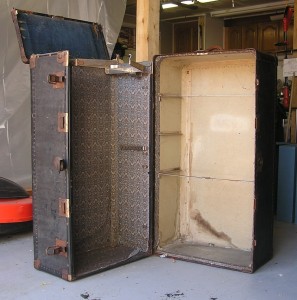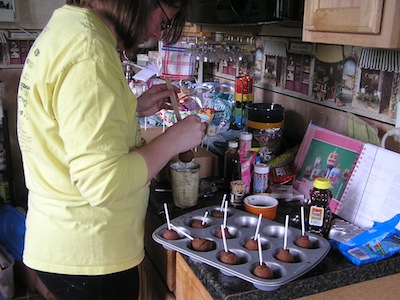We’ve recently been asked why we have cut back on the number of conventions we have been doing this year. We thought we would explain our decision through a lesson in Vendor Economics. We do an extensive Cost/Benefit analysis when making such decisions. What follows is a basic example of what it costs us to vend at a convention and break even on our expenses. This includes getting paid for our time, which is the only way we actually make a living since this is our full time job. (Most of the time that last part doesn’t actually happen and any “extra” funds get reinvested in the business.)
Below is a Glossary of Terms and explanation of the numbers we will be using in the calculations later in this article:
Booth Fee – Prices for booth space vary from con to con. Looking back over the 10 conventions we did last year, the average price for a booth was about $200.
Hotel Stay – Most convention hotels average around $100/night. For a three day con vendors usually show up a day early for set up. So, that is 3 nights, at least. If you have to drive more than a few hours you may need to stay over an extra night after tearing down and loading up. For this purpose we will assume a 3 night stay. $300
Gasoline – The closest Steampunk con is 3 hours away for us (approximately 150 miles). We have driven farther, but, honestly, it just wasn’t worth it. We have to drive a van to haul our merchandise and booth display. At 15 miles per gallon for 150 miles that is 10 gallons of gas each direction at $3.50/gallon. (150/15=10, 10x2x3.5=70) $70
Driving Time – again, this varies, obviously with your home location and the location of the show. Let’s use the 3 hours drive from the gasoline example for consistency. That is a 6 hour round trip for two people in the car. If we were to get paid a driver’s wage for that, we would make approximately $13.50/hr (based on national averages for delivery drivers). (13.50x6x2=162) $162
Merchandise – the cost of merchandise varies widely as well, but for argument’s sake we will take a conservative estimate and say that merchandise is marked up 100%. Example: you buy an item for $5, and sell it for a $10. If you are surprised at this, we apologize that you are unaware of how commerce and retail works. The discussion of mark-up rates and pricing is the topic of another conversation and we will not get into that here. But, using that example, you must take 50% of your gross revenue to just cover merchandise costs. EXAMPLE: if you make $2000, $1000 of that is up-front capital you have already invested in the sale and is sunk costs you need to recover. 50% of Revenue
Hourly Rate for Work – We arrive on Thursday (after 3 hours of driving) to set up the booth. It takes us about 3 hours to set up including hauling everything in around all the other vendors and getting checked in with the organizers, finding our booth, unpacking, etc. Vendor hall hours vary greatly and are usually at least 8-10 hrs a day. Sunday’s are often shorter and only about 6-8 hours. Let’s assume Friday is an 8-hour day, Saturday is a 10-hour day, and Sunday is a 6-hour day. That is 24 hours of “OPEN” time. (8+10+6=24) Vendors are usually asked to be in the hall an hour prior to opening – add 3 hours; tear down is usually faster – about 2 hours. We are now at 32 hours for the weekend AT the con PER PERSON. (3 hrs set up + 24 hours work + 3 hours open prep + 2 hours tear down.) If we pay ourselves a minimum wage that is $7.25/hr for each person for 32 hours. (7.25x32x2= 480) $480
Meals – Living on the road you can eat pretty cheap. We did a show where we bought a jar of peanut butter and a loaf of bread and ate for several of the travel days on about $6.75. However, most people eat out while working, if they get to eat at all. If we assume breakfast is included with the hotel stay (which is actually not as common as you might think) then we have lunch and dinner to cover. Corporate per diem rates vary by location, but for our zip code in Ohio the per diem rate for meals and incidentals is $51 (http://www.gsa.gov/portal/category/21287). We will lower that to $30 since we are cutting out breakfast. $30 per person for 2 people for 4 days (1 travel day + 3 con days) is $240. Seems pretty high to us, but even at $20/day it is still $160. Without access to a fridge or kitchen it is difficult to keep the prices much lower. $160
Credit Card Fees – Credit Card Fees vary based on the type of card used, transaction fees, and your card processor. For this example we will use The Square base rate of 2.75%. You have to take 2.75% off the top of whatever you make to cover the fees. 2.75% of gross revenue*
Sales Tax – We will use an average of 7% for this calculation. We have vended in places where it was as much as 10% and as low as zero on certain items (e.g. clothing in NJ is not taxed, but everything else is). 7% of gross revenue**
Licenses – Getting a business and/or tax license in a foreign location (not your home county/state) can be free or cost upwards of $150. You might not think this should count in the calculations, but it is a cost for doing business in the location and does have an impact on your bottom line. Average $50 ***
Here are the numbers we are working with:
Booth Fee $200
Hotel Stay $300
Gasoline $70
Driving Time $162
Merchandise 50% of total revenue
Meals $160
Hourly Rate $480
Licenses $50
Sales Tax 7% of revenue
Credit Card Fees 2.75% of revenue
59.75% of revenue + $1422 = what you need to make just to break even on your investment.
100%-59.75%=40.25%. $1442 is 40.25% of what you need to make.
1442/.4025=gross revenue needed = $3582.61
Most Steampunk conventions we’ve attended seem to be thrilled reporting attendance numbers of 500-1000 attendees. The question about these numbers is: Does that include all badges (performers, staff, and vendors as well as paid attendees) or just the off-the-street attendees? For argument’s sake we will give them the benefit of the doubt and say it is unique attendees. (Some large cons claim 15,000 in attendance, but use each day’s individual numbers and add them all together so people get counted every day they attend. Thus, one person attending all three days gets counted three times. In effect making their attendance number only 5000 in reality.)
If there are 1000 attendees, to make back your investment and break even (not having any profit), each attendee would need to spend $3.58 in your booth alone. (3582.61/1000=3.58261) It is highly unlikely to have every attendee spend money in your booth. But that’s okay, because most sales are an average of $17 (based on our personal calculations), so not every one needs to spend money with you, you just need the people who do spend with you to spend more than $3.58.
If there are 20 separate vendors (which these days is a conservative number) and we assume each vendor has similar monetary break-even needs, then the vendor hall needs to gross, on average, $71,652 for everyone to make their costs back. Thus, with 1000 attendees, each attendee needs to spend $71.65 in the vendor hall. Again, this doesn’t seem unreasonable, but remember this is just a BREAK-EVEN analysis. This isn’t anyone making a profit, funding their up-front costs for next year (or the next con), or making more than minimum wage. And, let’s be honest, who wants to start their own business and only ever make minimum wage? It also doesn’t give them any capital to invest into their business for new merchandise, tools, supplies, workforce, etc.
A few extra costs of doing business that we did not include in this analysis but bear mentioning include: Marketing (business cards, posters, flyers, etc.); Change (most banks are not open during convention hours and you need to prepared to break the $20s people get from the ATM on their way to the con); Parking (some hotels can charge upwards of $28/day for large vehicle parking); Travel Expenses (costs increase exponentially if you need to travel longer than a few hours); Damaged/Stolen Merchandise (yes, it happens, probably more than people want to admit); Time Away from Your Business (time not spent making new merchandise, managing web sales, answering phones, etc.); and Incidental Costs (booth display, zip ties – we go through A LOT of those – shopping bags, internet access for credit card processing, vehicle maintenance, chiropractor visits, attorney fees, insurance).
We understand that each vendor is unique in their goals, business objectives, reasons for vending at conventions, etc. The numbers above are generic averages pulled from our experience. They are also based on the most conservative situation of travel we have in our experience. We have vended at shows in Washington, Colorado, Arizona, Texas, Georgia, Indiana, Ohio, Detroit, and Oklahoma, so we are no strangers to excessive travel for our business. We also run our business as the primary source of income for two people, therefore we think more in cost/benefit terms than many people we encounter who have other sources of income to pay for their hobby businesses.
When vendor hall organizers come up to us at the end of a show and ask us how we did, we often say, “Well, we had a good time, but we have to do the final numbers to see.” That is not a way to avoid the question or avoid potential judgement of our opinions on the show at hand. It is simply the facts.
If you have other ways of determining if a show is successful for you and your business or you would like clarification on any of the information provided above, we invite you to comment and/or ask questions. We welcome open discussion of this topic and believe everyone can benefit from honest communication and sharing of information.
* We are aware that many transactions are on a cash basis, but because of the varying rates charged by credit card processing companies the 2.75% is a conservative estimate and it is simpler math to take it off the top of all $ made, instead of trying to guess what percentage of sales are credit vs. cash for this example. DISCLAIMER: we do not use The Square, we are not affiliated with The Square or the company that makes it, we have a credit card processing account with a company that covers our website AND onsite sales at conventions. We are simply using it as an example that is familiar to many vendors.
** Many people don’t collect, file, and/or pay their sales tax, but it is the law and we consider it a cost of doing business. While it is a break-even cost usually (i.e. what you take in is what you pay out), it is an expense that comes out of your total intake at the end of a convention and therefore you cannot look at your gross revenue without taking it into consideration.
*** While we are aware that many vendors do not apply for business and/or tax licenses in the locations where conventions occur, many of the planning organizations put it in their contract that you are responsible to do so and we take that seriously.












